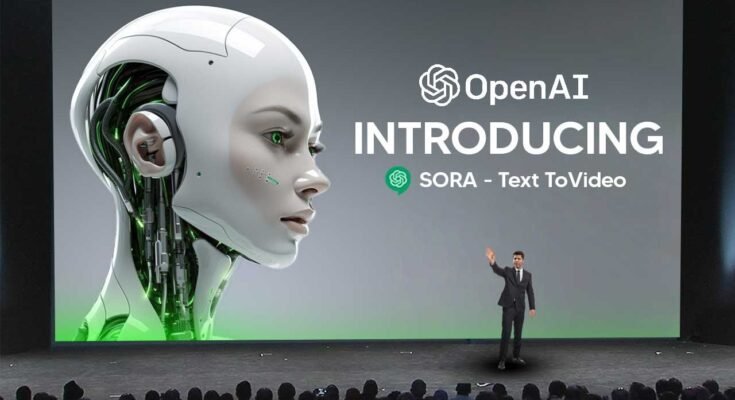In an era where media consumption is evolving at lightning speed, a groundbreaking innovation is redefining the landscape. Say hello to Sora, OpenAI’s latest marvel in text-to-video AI. This revolutionary technology stands poised to change how we create, share, and consume content. For content creators, tech enthusiasts, and AI innovators, understanding Sora’s potential is key to staying ahead in this rapidly shifting domain. This blog post will guide you through the intricacies of Sora, its applications, challenges, and its promising future.
The Impact of OpenAI’s Sora on the Media Landscape
OpenAI has consistently pushed the boundaries of artificial intelligence, and Sora is no exception. This cutting-edge text-to-video AI tool promises to transform media creation by enabling seamless conversion of written text into dynamic video content. Imagine typing out a script and having it materialize into a high-quality video within minutes. For content creators, marketers, and educators, this could mean more engaging and versatile content with a fraction of the effort.
But Sora’s implications go beyond convenience. By lowering the barriers to video production, it democratizes content creation, allowing individuals and small businesses to produce professional-level videos without expensive equipment or extensive technical expertise. In doing so, Sora is not just a tool but a catalyst for innovation and creativity in the digital age.
The Evolution of Text-to-Video AI
The development of text-to-video AI is a story of rapid technological advancements. Early attempts were rudimentary, often resulting in clunky and unconvincing outputs. However, with the advent of machine learning and neural networks, significant strides have been made. Today’s text-to-video AIs leverage vast datasets and sophisticated algorithms to generate videos that are remarkably realistic and contextually accurate.
Rewind a few years, and the idea of converting text directly into high-quality video would have seemed far-fetched. Yet, innovations in natural language processing (NLP) and computer vision have bridged the gap, making what was once science fiction a reality. OpenAI’s Sora represents the pinnacle of these advancements, combining state-of-the-art AI models with the capability to understand and visualize complex narratives.
Understanding Sora
At its core, Sora is powered by advanced machine learning algorithms designed to interpret and translate written text into visual media. It employs deep learning techniques to understand the nuances of language, context, and imagery. When fed a script, Sora analyzes the text, identifies key elements, and generates corresponding visuals, complete with animations and transitions.
What sets Sora apart is its ability to produce videos that are not only accurate but also highly engaging. By leveraging OpenAI’s GPT-3 model, Sora can understand intricate details and subtleties in the text, ensuring that the final video is both informative and visually appealing. This makes Sora an invaluable tool for a wide range of applications, from marketing campaigns to educational content.
Applications of Sora in Media Creation
The versatility of Sora opens up a plethora of opportunities across various sectors. In content marketing, for instance, Sora can help businesses create compelling video ads and social media content quickly, saving time and resources. By converting blog posts and articles into engaging videos, companies can reach wider audiences and enhance their marketing strategies.
In education, Sora can revolutionize the way instructional materials are created and consumed. Teachers and educators can transform lesson plans into dynamic video tutorials, making learning more interactive and accessible. This is particularly beneficial in remote learning scenarios, where engaging content is crucial for maintaining student interest and participation.
Furthermore, Sora can aid in the production of training videos for corporate environments, streamline video creation for news and media outlets, and even assist independent filmmakers in visualizing and producing their scripts. The possibilities are boundless, limited only by the creativity and imagination of the users.
Challenges and Ethical Considerations
While the potential of Sora is immense, it is not without its challenges and ethical considerations. One significant concern is the authenticity of AI-generated content. With the ability to create realistic videos, there is a risk of misinformation and deepfakes, which can have serious implications for trust and credibility.
Another challenge is the potential displacement of human jobs. As AI takes on more roles in media creation, the demand for human writers, editors, and producers may decrease. It is essential to consider the impact on the workforce and explore ways to integrate AI in a manner that complements rather than replaces human creativity and expertise.
Ethical use of AI is another critical aspect. Ensuring that AI-generated content is used responsibly and transparently is paramount. Clear guidelines and regulations are needed to prevent misuse and to safeguard the integrity of digital media.
Future Implications for Content Creation and Consumption
The future of content creation and consumption is bright with the advent of technologies like Sora. We can expect a surge in user-generated content, with individuals and small businesses producing high-quality videos effortlessly. This democratization of content creation will lead to more diverse and inclusive media landscapes, where a broader range of voices and perspectives can be heard.
For content creators, tech enthusiasts, and AI innovators, the focus will shift towards harnessing the full potential of Sora while addressing the associated challenges. Collaboration between AI and human creativity will be key to unlocking new possibilities and pushing the boundaries of what is achievable in media production.
We may also see the integration of Sora with other emerging technologies, such as augmented reality (AR) and virtual reality (VR), to create immersive and interactive content experiences. The fusion of AI with these technologies holds the promise of a new era in digital media, where storytelling knows no bounds.
Conclusion
OpenAI’s Sora is a game-changer in the world of media creation, offering unprecedented capabilities in converting text to video. For content creators, tech enthusiasts, and AI innovators, Sora represents a powerful tool that can streamline workflows, enhance creativity, and democratize access to high-quality video production.
As we look to the future, it is incumbent upon us to leverage this technology responsibly, addressing the ethical considerations and challenges that come with it. By doing so, we can ensure that Sora and similar innovations contribute to a richer, more diverse, and more engaging media landscape.
For those eager to explore the potential of Sora and stay ahead in the rapidly evolving world of digital media, now is the time to act. Engage with the community, experiment with the technology, and be part of the revolution that is reshaping the future of media.




